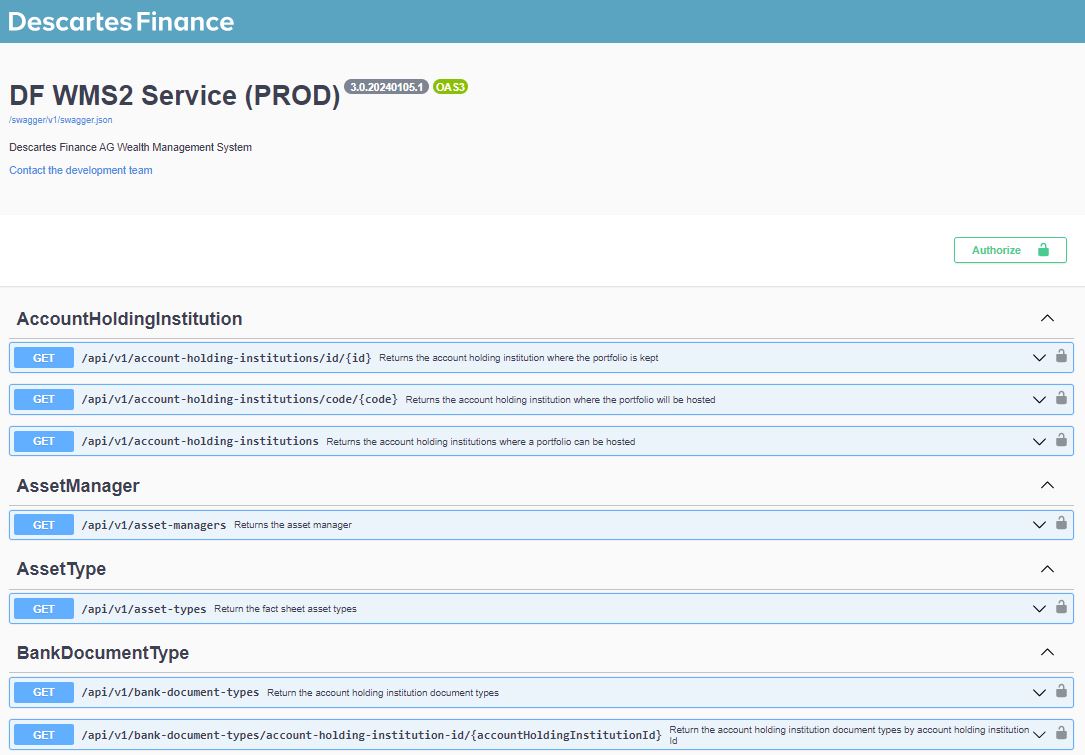Introduction
WMS2 is a service-oriented SaaS architecture that offers Restful Web API functionalities for wealth management and pension provision. The platform is fully integrated into Lienhardt’s foundations and its bank and enables the creation and management of wealth and pension solutions (3a and vested benefits).
Target groups
Users of this guide should have a certain level of experience in web and software development. In addition, the format of the receipt means that we focus on specific tasks rather than providing a general introduction. We will not cover the software development aspect. Instead, we will focus on the most common APIs and how to use them through examples organized in step-by-step code snippets.
APIs
The structure of the WMS APIs is described with Swagger and can be found here. The responses of the APIs return JSON in accordance with the standard HTTP protocol.

C# Examples
The example code snippets written with C# .NET CORE, can be downloaded from https://github.com/descartes-finance/Descartes.Wms2.HowToUse.Mvc.
Java Examples
The example code snippets written with Java, can be downloaded from https://github.com/descartes-finance/Descartes.Wms2.HowToUse.Java.
DTO
To avoid large and difficult to read code snippets, not all DTO definitions are listed. The DTO code definitions are part of the sample application.
With a JSON responses as follow:
{
"id": 0,
"code": "string",
"name": "string"
}
Our DTO looks like:
public class GenderOutputModel
{
public long Id { get; set; }
public string Code { get; set; }
public string Name { get; set; }
}
import com.google.gson.annotations.SerializedName;
public class GenderOutputModel {
@SerializedName("id")
public long Id;
@SerializedName("code")
public String Code;
@SerializedName("name")
public String Name;
}
Requirements
In order to work with the APIs, a JSON token is required for authorization. Without this token, any HTTP call will be considered unauthorized and will return a 401.
If you need a GUEST token, please contact us at info@descartes.swiss.
Once you have the authorization token, set the html header as shown below:
Authorization: Bearer e+JhsciOiJIU3sd1NiIsI#°§R5cCI6IkpXVCJ9.eyJwcml$£3JpeXBzaWQiOiJZVUgiLCJuYW1è?xN0Iiwseg@xNjczaaI8lHpVy...
There are different types of authorization tokens: GUEST, CUSTOMER, SELLER, ADMIN and SUPERADMIN.
TThe GUEST token is required for customer self-registration or customer login. After registration or customer login, the Web API returns a CLIENT token, which must be used for all further API calls. Normally, the authorization token has a validity period of one hour.
There are cases in which the authorization token has a longer validity period. The GUEST token, which is used to initiate the customer's self-registration, or the token used to initiate the login process, has a long validity period. ADMIN tokens used in an integration solution with server-to-server calls can have a long validity period.
HTTP proxy
Once we have received the authorization token, we proceed with the initialization of an HTTP proxy:
const string BASE_URL = "https://test.wms2-app.descartes-finance.com";
const string GUEST_TOKEN = "YOUR AUTHENTICATION TOKEN";
using var httpClient = new HttpClient { BaseAddress = new Uri(BASE_URL) };
httpClient.DefaultRequestHeaders.Accept.Add(new MediaTypeWithQualityHeaderValue("application/json", 1));
httpClient.DefaultRequestHeaders.AcceptLanguage.Add(new StringWithQualityHeaderValue("de-DE", 1));
httpClient.DefaultRequestHeaders.Authorization = new AuthenticationHeaderValue("Bearer", GUEST_TOKEN);
var BASE_URL = "https://test.wms2-app.descartes-finance.com";
var GUEST_TOKEN = "YOUR AUTHENTICATION TOKEN";
var httpClient = HttpClient.newHttpClient();
HttpRequest request = HttpRequest.newBuilder()
.timeout(Duration.ofMinutes(1))
.uri(URI.create(BASE_URL + "/genders/code/MALE"))
.header("Accept-Language", "de-DE")
.header("Authorization", "Bearer " + GUEST_TOKEN)
.header("Content-Type", "application/json")
.build();
Error handling
API errors conform to IETF Internet standards and are returned as HTTP response status codes.
To help you understand the reason for the error, the API also returns a payload containing detailed information about the problem.
There are three different types of error response, based on the HTTP error code.
All Descartes ErrorCode are available to the address api/v1/system/error-codes.
Unauthorized
{
"ErrorCode": "string",
"Message": "string",
"RemainingAttempts": int
}
Bad Request
{
"ErrorCode": "string",
"Message": "string"
"ValidationErrors":
{
// Field name 1
"string":
[
{"ValidationErrorCode":"string","ValidationErrorMessage":"string"}
],
// Field name 2
"string":
[
{"ValidationErrorCode":"string","ValidationErrorMessage":"string"}
],
...
...
// Field name N
"string":
[
{"ValidationErrorCode":"string","ValidationErrorMessage":"string"}
],
}
}
{
"ErrorCode": "string",
"Message": "string"
"ValidationErrors": null
}
Assuming you are making a POST/PUT request containing invalid values for CustomerID, CustomerName and CustomerSurname:
var payload = JsonConvert.SerializeObject(new
{
CustomerID = (long?)null,
CustomerName = "A",
CustomerSurname = "Dea#§"
});
var httpResponseMessage = await httpClient.PostAsync("api/v1/users", new StringContent(payload, Encoding.UTF8, "application/json"));
if (httpResponseMessage.IsSuccessStatusCode == false)
{
if (httpResponseMessage.StatusCode == System.Net.HttpStatusCode.BadRequest)
{
var errorContent = await httpResponseMessage.Content.ReadAsStringAsync();
var validationErrorModel = JsonConvert.DeserializeObject<ValidationErrorModel>(errorContent);
}
}
var payload = "{ 'CustomerID': null, 'CustomerName': 'A', 'CustomerSurname': 'Dea#§' }";
HttpRequest Request = HttpRequest.newBuilder()
.timeout(Duration.ofMinutes(1))
.uri(URI.create(Program.BASE_URL + "users"))
.header("Accept-Language", "de-DE")
.header("Authorization", "Bearer " + Program.ADMIN_TOKEN)
.header("Content-Type", "application/json")
.POST(HttpRequest.BodyPublishers.ofString(payload))
.build();
var response = client.send(Request, BodyHandlers.ofString());
if (response.statusCode() == 400) {
//System.out.println(response.body());
ValidationErrorModel errorsObj = new Gson().fromJson(response.body().toString(), ValidationErrorModel.class);
//var howManyErrors = errorsObj.validationErrors.size();
//System.out.println(howManyErrors);
}
{
"ErrorCode":"VALIDATION-ERRORS",
"Message":"Request contains one or more invalid fields.",
"ValidationErrors":
{
"CustomerId":[{"ValidationErrorCode":"INVALID-FIELD","ValidationErrorMessage":"Customer ID is mandatory"}],
"CustomerName":[{"ValidationErrorCode":"INVALID-FIELD","ValidationErrorMessage":"Customer name is too short"}],
"CustomerSurname":[{"ValidationErrorCode":"INVALID-FIELD","ValidationErrorMessage":"Customer surname cannot contain special characters"}]
}
}
For all cases where the bad request response does not have a list of invalid fields:
....
....
var httpResponseMessage = await httpClient.PostAsync(url);
if (httpResponseMessage.IsSuccessStatusCode == false)
{
if (httpResponseMessage.StatusCode == System.Net.HttpStatusCode.BadRequest)
{
var errorContent = await httpResponseMessage.Content.ReadAsStringAsync();
var validationErrorModel = JsonConvert.DeserializeObject<ValidationErrorModel>(errorContent);
}
}
{
"ErrorCode":"STARTING-DATE-IS-NEEDED",
"Message":"starting-from is mandatory.",
"ValidationErrors": null
}
All others errors
{
"ErrorCode": "string",
"Message": "string"
}
Pagination
Pagination is a way of breaking up large parts of content into smaller pieces.
Some API endpoints can retrieve data using pagination. The pagination parameters are passed via a query string:
- pageNumber
- pageSize
As a result, the response will contain an X-Defi-PageMetadata HTTP header. This is a JSON object with the following pagination result properties:
- totalCount
- currentPage
- pageSize
- totalPages
- previousPageLink
- nextPageLink
HTTP POST
All HTTP POST and PUT requests return a payload containing the generated object.
Also for POST, the HTTP Location header contains the URL of the entity created.